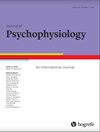Increased Motor Cortex Excitability for Concealed Visual Information
IF 0.9
4区 心理学
Q4 NEUROSCIENCES
引用次数: 1
Abstract
Abstract. Deceptive behavior involves complex neural processes involving the primary motor cortex. The dynamics of this motor cortex excitability prior to lying are still not well understood. We sought to examine whether corticospinal excitability can be used to suggest the presence of deliberately concealed information in a modified version of the guilty knowledge test (GKT). Participants pressed keys to either truthfully or deceitfully indicate their familiarity with a series of faces. Motor-evoked potentials (MEPs) were recorded during response preparation to measure muscle-specific neural excitability. We hypothesized that MEPs would increase during the deceptive condition not only in the lie-telling finger but also in the suppressed truth-telling finger. We report a group-level increase in overall corticospinal excitability 300 ms following stimulus onset during the deceptive condition, without specific activation of the neural representation of the truth-telling finger. We discuss cognitive processes, particularly response conflict and/or automated responses to familiar stimuli, which may drive the observed nonspecific increase of motor excitability in deception.运动皮层对隐藏视觉信息的兴奋性增强
摘要欺骗行为涉及复杂的神经过程,涉及初级运动皮层。这种运动皮层在说谎前的兴奋性的动力学仍然不太清楚。我们试图在有罪知识测试(GKT)的修改版本中检验皮质脊髓兴奋性是否可以用来暗示故意隐瞒信息的存在。参与者按下按键,以真实或欺骗性地表明他们对一系列面孔的熟悉程度。在反应准备过程中记录运动诱发电位(MEP),以测量肌肉特异性神经兴奋性。我们假设,在欺骗性条件下,不仅在说谎的手指中,而且在被抑制的说谎手指中,MEP都会增加。我们报告了在欺骗性条件下,刺激开始后300ms,皮质脊髓整体兴奋性在组水平上增加,而没有特定激活说出真相的手指的神经表征。我们讨论了认知过程,特别是对熟悉刺激的反应冲突和/或自动反应,这可能会导致在欺骗中观察到的运动兴奋性的非特异性增加。
本文章由计算机程序翻译,如有差异,请以英文原文为准。
求助全文
约1分钟内获得全文
求助全文
来源期刊

Journal of Psychophysiology
医学-神经科学
CiteScore
2.60
自引率
7.70%
发文量
25
审稿时长
>12 weeks
期刊介绍:
The Journal of Psychophysiology is an international periodical that presents original research in all fields employing psychophysiological measures on human subjects. Contributions are published from psychology, physiology, clinical psychology, psychiatry, neurosciences, and pharmacology. Communications on new psychophysiological methods are presented as well. Space is also allocated for letters to the editor and book reviews. Occasional special issues are devoted to important current issues in psychophysiology.
 求助内容:
求助内容: 应助结果提醒方式:
应助结果提醒方式:


